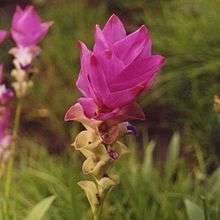Curcuma alismatifolia
Curcuma alismatifolia, Siam tulip or summer tulip (Thai: ปทุมมา, RTGS: pathumma; กระเจียวบัว, RTGS: krachiao bua; ขมิ้นโคก, RTGS: khamin khok) is a tropical plant native to Laos, northern Thailand, and Cambodia.[1][2] Despite its name, it is not related to the tulip, but to the various ginger species such as turmeric. It can grow as an indoor plant, and is also sold as a cut flower.
| Siam tulip | |
|---|---|
 | |
| Scientific classification | |
| Kingdom: | Plantae |
| Clade: | Tracheophytes |
| Clade: | Angiosperms |
| Clade: | Monocots |
| Clade: | Commelinids |
| Order: | Zingiberales |
| Family: | Zingiberaceae |
| Genus: | Curcuma |
| Species: | C. alismatifolia |
| Binomial name | |
| Curcuma alismatifolia | |
| Synonyms[1] | |
|
Hitcheniopsis alismatifolia (Gagnep.) Loes. in H.G.A.Engler | |
A field of wild Siam tulips in Pa Hin Ngam National Park, Thailand
One of the most famous wild fields of Siam tulips is in Pa Hin Ngam National Park in Chaiyaphum Province, Thailand.
Malvidin 3-rutinoside is a pigment responsible for bract color in C. alismatifolia.[3]
References
- Kew World Checklist of Selected Plant Families
- Sirirugsa, P., Larsen, K. & Maknoi, C. (2007). The genus Curcuma L. (Zingiberaceae): distribution and classification with reference to species diversity in Thailand. Gardens' Bulletin Singapore 59: 203-220.
- Nakayama, M; Roh, MS; Uchida, K; Yamaguchi, Y; Takano, K; Koshioka, M (2000). "Malvidin 3-rutinoside as the pigment responsible for bract color in Curcuma alismatifolia". Bioscience, Biotechnology, and Biochemistry. 64 (5): 1093–5. doi:10.1271/bbb.64.1093. PMID 10879491.
External links
| Wikimedia Commons has media related to Curcuma alismatifolia. |
| Wikispecies has information related to Curcuma alismatifolia |
This article is issued from Wikipedia. The text is licensed under Creative Commons - Attribution - Sharealike. Additional terms may apply for the media files.
